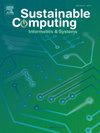Maximizing solar energy harvesting efficiency: Optimal hybrid deep neural learning - based MPPT for Photovoltaic systems under complex partial shading conditions
IF 5.7
3区 计算机科学
Q1 COMPUTER SCIENCE, HARDWARE & ARCHITECTURE
引用次数: 0
Abstract
The declining viability of fossil fuels and their adverse environmental impacts are accelerating the global transition to Renewable Energy Sources (RESs), with solar energy emerging as a key pillar due to its versatility and scalability. Photovoltaic (PV) systems enable direct solar-to-electric conversion but face challenges such as nonlinear behavior and multiple Local Maximum Power Points (LMPPs) under Complex Partial Shading Conditions (CPSCs). This study introduces an enhanced Maximum Power Point Tracking (MPPT) method based on a hybrid Artificial Neural Network–Improved Incremental Conductance (ANN-IINC) model. The ANN is trained using representative datasets capturing diverse shading patterns to estimate optimal reference voltages dynamically, while the IINC module accelerates convergence with reduced oscillations. To validate the proposed method, three CPSC scenarios are simulated and compared with traditional perturb and observe and INC techniques, as well as recent metaheuristic optimization algorithms. Sensitivity and descriptive statistical analyses confirm that the ANN-IINC approach not only achieves faster convergence (81.9 ms) and higher tracking accuracy (up to 99.9096 %) but also reduces standard deviation in power output by 11.3 %–14.8 % compared to classical methods. Furthermore, confidence intervals for efficiency are narrowed by over 20 %, demonstrating improved robustness and statistical significance. The method's computational complexity is optimized, maintaining real-time applicability without sacrificing precision. A comprehensive adaptive analysis and hyperparameter sensitivity study further reinforce the superiority and practical relevance of the hybrid architecture. The study offers a scalable, stable, and efficient solution to the MPPT problem under dynamic environmental conditions. These results highlight the ANN-IINC technique’s capacity to outperform both classical and metaheuristic MPPT strategies, contributing meaningfully to the advancement of intelligent PV control under CPSCs.
最大化太阳能收集效率:复杂部分遮阳条件下光伏系统的最优混合深度神经学习MPPT
化石燃料的生存能力下降及其对环境的不利影响正在加速全球向可再生能源(RESs)的过渡,太阳能因其多功能性和可扩展性而成为关键支柱。光伏(PV)系统实现了太阳能到电力的直接转换,但面临着非线性行为和复杂部分遮阳条件下的多个局部最大功率点(lmpp)等挑战。提出了一种基于混合人工神经网络改进增量电导(ANN-IINC)模型的增进型最大功率点跟踪方法。人工神经网络使用捕获不同阴影模式的代表性数据集进行训练,以动态估计最佳参考电压,而IINC模块通过减少振荡来加速收敛。为了验证所提出的方法,模拟了三种CPSC场景,并与传统的扰动和观察和INC技术以及最近的元启发式优化算法进行了比较。灵敏度和描述性统计分析证实,ANN-IINC方法不仅收敛速度快(81.9 ms),跟踪精度高(99.9096 %),而且输出功率的标准差比经典方法降低了11.3 % ~ 14.8 %。此外,效率的置信区间缩小了20% %以上,显示出改进的稳健性和统计显著性。优化了该方法的计算复杂度,在不牺牲精度的前提下保持了实时性。综合自适应分析和超参数敏感性研究进一步强化了混合结构的优越性和实际意义。该研究为动态环境条件下的MPPT问题提供了一种可扩展、稳定、高效的解决方案。这些结果突出了ANN-IINC技术优于经典和元启发式MPPT策略的能力,为cpsc下光伏智能控制的发展做出了有意义的贡献。
本文章由计算机程序翻译,如有差异,请以英文原文为准。
求助全文
约1分钟内获得全文
求助全文
来源期刊

Sustainable Computing-Informatics & Systems
COMPUTER SCIENCE, HARDWARE & ARCHITECTUREC-COMPUTER SCIENCE, INFORMATION SYSTEMS
CiteScore
10.70
自引率
4.40%
发文量
142
期刊介绍:
Sustainable computing is a rapidly expanding research area spanning the fields of computer science and engineering, electrical engineering as well as other engineering disciplines. The aim of Sustainable Computing: Informatics and Systems (SUSCOM) is to publish the myriad research findings related to energy-aware and thermal-aware management of computing resource. Equally important is a spectrum of related research issues such as applications of computing that can have ecological and societal impacts. SUSCOM publishes original and timely research papers and survey articles in current areas of power, energy, temperature, and environment related research areas of current importance to readers. SUSCOM has an editorial board comprising prominent researchers from around the world and selects competitively evaluated peer-reviewed papers.
 求助内容:
求助内容: 应助结果提醒方式:
应助结果提醒方式:


